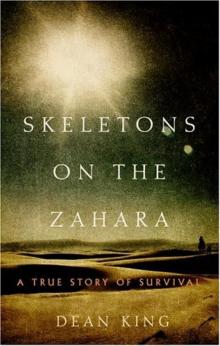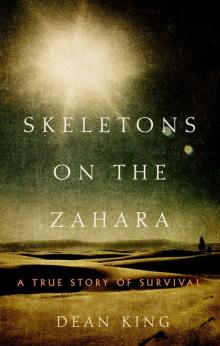Skeletons on the Zahara: A True Story of Survival Read online
Page 19
Hamet’s group stayed with these nomads two more days, traveling fifteen miles north with them. The tribe treated both the Bou Sbaa and their captives as honored guests, erecting tents even for the Christians. Although their sheep were perishing, barely able to stand and graze on the brown moss, the Arabs lavished milk on their guests at night. Unsure when they would eat again, the sailors gorged until they vomited.
On October 5, they left this band of Arabs, who had impressed Riley and his crew with a generosity that was as liberal to the lowly slave as it was to the master. Hamet bought a sheep and traded his young camel for an old one and a calf. The old camel soon proved to be lame in the right forefoot. They called it Coho, “Lame,” and the calf Goyette, “Little Child,” though it was big enough to carry an emaciated sailor on its back.
Riley led the sheep with a rope tied around its neck until noon, when they reached a small valley with a bir sunk amid bushes with thick roots. This was no small find. Until recent times, Western Sahara, a region the size of Colorado, possessed only about a hundred known sources of potable water. Wells tapping them—categorized by their depth, a hassi being as deep as forty feet and a bir anything deeper—are so essential and the land otherwise so devoid of landmarks that even modern maps show their locations.
They pulled up bucket after bucket from the deep well, each man drinking as much as he wanted. After watering the camels and filling two goatskins, they slaughtered the sheep, which could not keep up. When Riley started to clean the entrails, the Bou Sbaa stopped him, put them, still intact, back inside the carcass, and slung it across a camel. They mounted again and continued northwest, driving riderless Coho on in front.
That night, the Bou Sbaa roasted and ate two of the mutton quarters while the sailors devoured the offal nomad-style—with its partially digested grain still inside. On the morning of October 6, they set off on foot, driving the camels on in front of them. Since leaving the chasm, Riley had noticed that Hamet, Seid, and Abdallah had more trouble navigating. Before, they had steered by the desert’s landmarks. Now they seemed more concerned about their location, frequently checking the sun and the wind and dismounting at sandy patches on the hammada to smell the sand. By the middle of the morning, even the sailors began to notice signs of change. The sand that lay in small, loose heaps began to mount. The distant terrain took on an ominous, choppy look, like the sea under an approaching storm. By early afternoon, wind-borne grit stung their skin.
For another week, Ganus’s family remained in Robbins’s so-called Valley of the Shadow of Death, where, empty-handed, they searched farther and farther afield for sustenance and pushed the limits of tribal obligation, borrowing, cajoling, and filching from those who still had milk or a cache of food or water. One of Ganus’s camels had gone dry, reducing their milk supply to four quarts a day.
Robbins and Hogan crossed the hill to the east into another valley, where they found snails. Robbins stashed his in his sailcloth satchel until they could take fire from a camp and roast them. So reduced were the Arabs that when the pair returned to Ganus’s tent for zrig and Ganus discovered what they had found and eaten, he scolded them for not sharing. It was a fair rebuke, Robbins had to allow, since Ganus was always as generous as his circumstances permitted.
What Robbins could not abide was the Sahrawis’ resignation in the face of starvation. As he put it, “to waste away and go down to the grave for the want of food was too much for the small portion of philosophy imparted to me to endure with fortitude.” How maddening it was to persist on the barren Sahara and not make an effort to leave it while they still had strength. What sailor becalmed in the horse latitudes would not make every effort to set his vessel in motion again? Unable to fill their stomachs on snails, Robbins and Hogan now investigated the refuse around the camps. A pile of decaying camel bones had already been gnawed by dogs, but the sun had softened them. Robbins dug into a crevice with his teeth for a bit of gristle and nearly dislocated his jaw.
The next day, Robbins saw Deslisle for the first time since leaving the well near Cape Barbas. The cook was returning from the hilltop where he had been keeping the animals. He appeared relatively hearty and had better clothes than Hogan. Robbins and Hogan greeted Deslisle eagerly, but his mistress saw him at the same time and ordered him to keep moving. Anxious to speak to Robbins, Deslisle lingered, which infuriated the woman. She attacked him, cuffing and clawing his head. Deslisle did not dare strike back. She dragged him up the hill, scolding him loudly, and at the top, Mohammed knocked him down and clubbed him repeatedly. Deslisle could do nothing to defend himself. As he cried out in pain, Robbins fumed. “Never did I more ardently pant to revenge the injury of a shipmate,” he recalled later. “I was desperate but knew I must be humble and see my shipmate mauled to pumice.”
Near dusk, Robbins went to check on Hogan and Deslisle. He wore a new article of clothing that he had made to protect his skin from the sun. He had folded a yard-and-a-half square of the brig’s colors, cut a hole in the center, and sewn up the sides, leaving holes for his arms, to approximate a shirt. His mistress had sewn a dress out of a larger section of the flag and was vainly sashaying about camp in the latest fashion of “striped bunting.” Relishing the irony, Robbins mused that this was probably the first U.S. flag to fly over the Sahara. Arriving at Hogan’s master’s tent, Robbins found that Deslisle was still out with the camels. Hogan was moribund. Robbins strutted around in his absurd new attire to cheer him up. “If you like this,” he jested, “you should see my mistress. She has also covered herself in glory.” He chuckled at his own joke, but Hogan could not shake his dark cloud. His effort at laughter ended in a sorry hiccup of despair.
“Yesterday,” he muttered to Robbins, “good Dick brought me some cooked snails. But our confounded master would not suffer me to eat them. I will starve soon.” Robbins tried to reassure Hogan, but nothing seemed to work. He wished Deslisle would come in, but the cook still had not arrived by the time Robbins had to return to his master’s tents. He never saw Deslisle again.
A blast of heat hit Riley like campfire smoke in a sudden gust, and he broke out in a clammy sweat. It had been just three days since he, Savage, Horace, Clark, and Burns had saturated themselves with water, laughing like children. Now as they labored through burning sand, chronic diarrhea plagued them. Clark and Burns and the rebellious second mate appeared wan even in their desert color. As thin as scarecrows, they looked like they might combust and vanish in a puff. Horace was already little more than a vapor.
Before the group had trudged long, Hamet assigned the men to camels. As the beasts rose, the sailors looked out on an awe-inspiring sight. Stretching to the north and south as far as they could see, dunes towered hundreds of feet high. Wind-ripped crests gave them the appearance of storm-churned sea rollers, Poseidon’s anger writ in grit.
The trade winds, which had cooled their bodies under the broiling sun, “now blew like a tempest” and became their “formidable enemy,” Riley wrote. “The loose sand flew before its blasts, cutting our flesh like hail stones, and very often covering us from each other’s sight, while the gusts (which followed each other in quick succession) were rushing by.”
On the sliding hills, the camels faltered and sank into the sand. An anxious Hamet ordered everyone to dismount. He, Seid, and Abdallah went ahead to find a route. On foot, the sailors struggled to keep up with the camels, especially on the downhill slopes. At the same time, they had to make sure that old Coho, walking with no load at all, did not lag behind, or they would be beaten.
Wind and sand. Sand, wind. They saw nothing else for two days, as the irifi, the region’s legendary desert wind, unleashed its fury on them. The two elements sucked and scoured all the moisture out of their bodies and tore at their skin to get more. The first day, they struggled on for five hours until around dark, when they discovered a flat trough, like a “lake surrounded by mountains,” where some shrubs grew. While the camels chewed the leaves and limbs of the bushes, the men pushed
sand up against the saddles to form a barrier against the wind. They cooked the remainder of the mutton, pulverizing the bones with rocks so that they could eat them too. “It was sweet to our taste, though but a morsel,” Riley wrote.
At dawn the next day, Hamet ordered Riley to gather the camels. He, Savage, and Clark quickly found the two strongest, which were fettered, their forelegs tied together about a foot apart, so that they could hobble around to feed but not run far. Riley went for Seid’s, the spunkiest, leaving Savage the big one. The captain, who was fast learning how to handle the beasts, which were never bridled or haltered, made the camel kneel, took off its fetter, and climbed on, using a goad and soothing words to guide it.
While he was doing this, Savage made the mistake of unfettering the big camel before making it kneel. Just then, lame and recalcitrant Coho, who had given the men so much trouble by lagging, bolted to the south. Goyette, the calf, followed. Bellowing, Hamet’s big camel wrenched free of Savage’s grasp and dashed off at a full gallop. Abdallah’s camel followed.
Riley struck his swift camel with the goad. He soon caught up with the runaways and maneuvered in front of them. He tried to head them off, but they bumped him and dodged by, at a full gallop, weaving around the dunes. The impulse to flee was contagious. All at once, Seid’s camel went berserk trying to free itself of Riley. It bolted, bucking its suddenly flexible body, bellowing and growling like a wild animal. Rafts of stinking froth flew from its mouth into Riley’s face. He hung on desperately. In response, the fiendish camel lay down and rolled over, dumping him, then reared its head and gnashed its teeth against his thighs. Riley leaped back on the animal before it could rise to its feet again.
The camel’s fury was spent. He had beaten it. He guided it near the others, now a good distance from camp, but he could not make the stubborn brutes turn. Fearing that he was lost in the tortuous sand hills, he stopped his camel and turned back.
The three angry Bou Sbaa came running over the dunes. Hamet shouted for Riley to make his camel lie down and to get off. Catching up, Hamet leaped on, wheeled the rising animal, and sped off with Seid and Abdallah tailing him on foot. Riley followed their tracks back to camp, where he ruefully collected some skins that Goyette had dumped. The Arabs did not return for three hours. As the time passed, Riley grew increasingly frightened for Savage, who would certainly be severely beaten for causing this trouble and might not survive it in his current state.
As the Bou Sbaa rode back into camp, Riley encouraged Savage to apologize or plead for mercy, but he refused, enraging the Arabs even more. Riley begged for forgiveness on Savage’s behalf, but the Arabs, fuming and hungry for vengeance, ignored him, grabbed Savage, and beat him with their camel goads. They accused him of driving off the camels on purpose, spat at him, and pronounced him foonta, or bad. Savage survived, but he would suffer further from this reputation.
It was nine o’clock before they set out again, as close to north-northwest as the sand hills would allow. For two hours, they wound through passes between slopes at a trot. Then the hills became so thick and treacherous that Hamet feared for the camels and bade the men all to dismount. The Bou Sbaa went ahead to scout a route, spreading themselves out so that they could relay directions. The sailors followed with the camels, taking the utmost care to keep the beasts in line.
They walked at a miserable pace through sand heated until it felt like “wading through glowing embers.” Wind-borne grit coated their bodies. For twelve chafing hours they marched with nothing to consume, finally stopping aloft on the sea of dunes, where there was no forage at all for the camels. Exhausted and frustrated, the men each had a drink of water before collapsing in comalike slumber. In the dead of night, Riley awakened with a start. He heard and felt in his shivering body a low, distant rumbling to the north that was not just the wind. The noise reverberated with the force of a hurricane. It must be a hurricane of sand, he reasoned, which will bury us alive.
He rose in a panic and woke his men, who listened in shocked silence, convinced that the distant thunder was the sound of their impending death. At first they were certain it was a noise unlike any they had ever heard before. But soon someone noticed that the rumbling, though persistent, grew no closer and the wind no stronger. Suddenly acutely aware of his mistake, Riley announced, “It’s the sea!”
On October 3, Archie Robbins hiked seven miles over the hilltop to see William Porter and amuse him with his sartorial use of the Stars and Stripes. His timing was fortuitous. Porter’s master and another Arab were heading up the valley to a tent where a camel had been slaughtered. Porter and Robbins carried the Arabs’ muskets—“good double-barrelled pieces,” Robbins noted—as they walked.
Robbins’s nostrils twitched with hunger as the aroma of thornbush smoke and roasting camel filled the camp. Porter’s master and his friend devoured the meat they were given and tossed the warm bones to the sailors, who tore at them with their teeth and fingernails, scraping away every shred of gristle and cracking them open for the marrow. While the Arabs drank milk afterward, the Americans went thirsty.
The following day, however, Robbins and Porter were provided for in the most unimaginable way. Among the more primitive of the Sahrawis’ animist beliefs were those regarding that rare event, rain. When dark clouds appeared, the nomads took great pains not to upset them; in fact, they were forbidden even to look at them, except through eyes darkened with kohl. Nor were they allowed to talk about them. Children’s games were halted out of respect.
In this instance, the Bou Sbaa behaved to the clouds’ satisfaction. In a land where rain falls as rarely as once every six years, they received their small miracle: a brief but violent shower. As soon as it began, the women took up their geddacks and sponges and rushed over to the rock slabs on the hills, according to Robbins. They did not set their bowls out to catch the rain, because—however perverse—this too was forbidden by Sahrawi custom. Only after the shower had passed were they free to sponge up the standing water and squeeze it into their geddacks. Heedless, Robbins lay on his stomach on the rocks and slurped up little rivulets. After a few minutes, the sun returned as strong as ever. He “licked and sucked” the rocks until they were dry.
The excitement did not wear off right away, and the nomads celebrated with gleeful chatter. The shower had brought something more valuable than water to Robbins too: hope. Perhaps his life did not depend entirely on the nomads. Perhaps Providence would play a role. He could hear laughter coming from the tent where the women had returned after filling a goatskin, and for once he did not resent it.
Two days later, Ganus and his sisters, Ishir and Muckwoola, set off with the camels to find water. Those who stayed behind had only snails and the dregs of the goatskins to live on. Robbins begged at neighboring tents, invoking his mistress’s name to elicit generosity, but the valley was used up and the nomads were beginning to leave. As the number of tents dwindled, Robbins cast a wider circle. Five miles from the tents, looking up from the hardpan, he saw a large turbaned Arab racing toward him on a straining camel. Above his head, the man waved a gleaming scimitar ready to slice him in two. A nauseating fear overwhelmed him, yet it was tinged with relief. The end, it seemed, had finally come.
chapter 12
Honor Among Thieves
Captain Riley and his men had come full circle. The Sahara had taken the Commerce from them, reduced them, and sent them away, but now they were back. They could hear the waves crashing at Cape Bojador—a fact that Sidi Hamet confirmed—over the bones of the Commerce. They had regained lost ground and reached a milestone. The news boosted the morale of the sailors, especially those who had remained skeptical of Hamet’s intentions. They quietly rejoiced at the proof that they were in fact heading toward the Empire of Morocco. At the same time, Hamet added an ominous fact: “You will get no more zrig,” he told Riley regretfully, shaking the collapsed goatskin.
Late in the morning of October 8, they began to see hard flat surfaces blown clean between the dunes
, as if the mountains of sand were merely piles sitting on a giant tabletop. Around noon they reached a clearing to the northeast, where they gazed out on open hammada, something the sailors had never thought they would be grateful to see. They were now within a day’s ride of Cape Bojador and entering a more populous region of the desert, occupied by two dozen tribes. Most, including the Oulad Bou Sbaa and their rivals the Oulad Delim, were deemed “ferocious” or “savage” by Moroccans as well as by Westerners. Brisson called the Oulad Delim “so . . . rapacious, that friends, or enemies, they are almost equally to be feared.”
As they neared the northern limits of the desert, they would have to penetrate the regions of the Reguibat tribe, near the Saguia el-Hamra wadi, and of the Tekna, who lived between the Saguia and Oued (wadi) Draa. North of the Draa, where the desert gave way to arid hills and then fertile valleys, lay Souss, the land unsubdued by the Sultan of Morocco and dominated by warlords with troops of mercenaries who roamed the countryside. They controlled the caravan traffic to Tombuctoo and the ransoming of shipwrecked Westerners whenever they could, both for profit and for the prestige it brought them. Hamet would have to elude them, as well as his own greedy father-in-law, who lived near Wednoon.
The sailors had hoped to bathe in, or at least gaze upon, the sea, preferably at Bojador, where they could find out whether the brig remained, but the dunes to the west did not diminish. When the breakthrough came, they headed nearly due east over deep but not piled sand. As they rode along the southern side of a ridge of dunes, the Bou Sbaa spotted two distant camels heading in a northeasterly direction. In urgent need of food and water, they lit out for them, with the sailors trailing behind.

 A Sea of Words
A Sea of Words Skeletons on the Zahara
Skeletons on the Zahara The Feud: The Hatfields and McCoys: The True Story
The Feud: The Hatfields and McCoys: The True Story Every Man Will Do His Duty
Every Man Will Do His Duty 9/11...The Tragic Story of the Day that Changed America: The Terror, The Horror and The Heroes
9/11...The Tragic Story of the Day that Changed America: The Terror, The Horror and The Heroes White Slave Cop
White Slave Cop Skeletons on the Zahara: A True Story of Survival
Skeletons on the Zahara: A True Story of Survival